Study of the Two-Phase Flow and Wear of a Pump with Mixed-Size Particles
Abstract
1. Introduction
2. Centrifugal Pump Experimental Study
3. Centrifugal Pump Computational Study
3.1. Simulation Settings
3.2. Geometry and Meshes
3.3. Simulation Accuracy Verification
4. Results
4.1. Analysis of Different Particle Conditions
4.2. Impeller Wear Analysis
4.3. Volute Wear Analysis
5. Discussion
- (1)
- At the rated point Q = 70 m3/h from PSD1 to PSD3, compared with 15.16 m in the clean-water conveying condition, the particle components in the solid–liquid two-phase centrifugal pump decreased to 13.39 m, 13.98 m, and 14.52 m, respectively. The decreasing amplitude was 11.68%, 7.78%, and 4.22%, respectively. Compared with 67.16% in the clean-water conveying condition, the efficiency decreased to 58.24%, 59.38%, and 60.39%, respectively, with the decreasing amplitude of 13.28%, 11.58%, and 10.08%, respectively. That is, the performance of the two-phase flow centrifugal pump increases with the proportion of small and medium-sized particles in the particle composition, the head and efficiency gradually improve, and the mixing efficiency of the centrifugal pump improves.
- (2)
- In the impeller of the mixed-particle solid–liquid two-phase flow of the centrifugal pump, the concentration of the particles was low at the inlet of the impeller, and the flow velocity at the inlet was lower than the flow velocity at the trailing edge of the pressure surface. The filling effect of small particles on large particles is not obvious. At the outlet of the pressure surface of the impeller, the particles were highly aggregated by the rotation of the impeller, and the filling effect of small particles around large particles could not be ignored. This effect caused a larger wear area and aggravated the wear.
- (3)
- Comparing the wall-velocity cloud map and the wall-particle volume fraction of the three different particle composition conditions in Figure 14, it could be found that the local velocity of PSD1 was the highest at the red circle, but the overall velocity distribution of the impeller and the volute wall was also the most uneven. The particle distribution on the wall of the volute of PSD1 was mainly concentrated in parts I and II. This was because the 3 mm large particles had a large volume and poor followability. They could easily collide with the wall in the impeller channel. Most of the large particles gained greater speeds after colliding with the pressure surface of the blade at the red circle and directly bounced away from the impeller channel. Then the large particles collided with the volute’s I and II flow channels, and a small number of the particles collided with the volute’s III flow channel after rotating with the impeller. As a result, the severely worn area of the volute in Figure 13 occurred in flow passages I, II, and III. The speed of PSD3 at the position of the red circle was the lowest among the three kinds of working conditions, but the overall wall speed and the particle distribution in the flow channel of the impeller and volute were the most uniform. Most of the particles followed the flow field and then were thrown out evenly. As a result, the overall wear area shown in Figure 13 was larger, but the severe wear area was smaller. The PSD2 working condition presented an intermediate state between PSD1 and PSD3.
6. Conclusions
- The particle components in the solid–liquid two-phase centrifugal pump have an obvious effect on the external characteristics of the centrifugal pump. With the increase of the small-particle component at the same mass concentration, the head and the efficiency of the centrifugal pump were significantly improved, and the mixing efficiency of the centrifugal pump was improved.
- For the condition of the total-mass fraction of the particles being constant, the wear area of the impeller was more concentrated in the PSD1 single-particle working condition, and the wear rate at the root of the impeller hub (position B) was the most serious of the three working conditions. The PSD2 working condition had a particle composition of 7:3. While the overall wear area is larger than that of PSD1, the wear rate of the trailing edge of the blade pressure surface is also 41% higher than that of PSD1 under the single-particle condition. In the PSD3 working condition with a particle composition of 3:7, the wear area of the volute and the impeller was the largest of the three working conditions, but the overall average wear rate was the lowest among the three working conditions.
- In the volute, with the increase of the small particle components in the particle composition, the area of the severely worn area of the I and II sections decreases, and the severely worn area of the V and VI sections increases. In the trend of transition from the II area to the V and VI areas, the overall wear area of the volute increases but the local severe-wear area decreases.
Author Contributions
Funding
Institutional Review Board Statement
Informed Consent Statement
Data Availability Statement
Conflicts of Interest
References
- Ma, W.B.; Schott, D.; Lodewijks, G. Continuous Line Bucket Lifting Versus Pipe Lifting. J. Offshore Mech. Arct. Eng. 2017, 139, 9. [Google Scholar] [CrossRef]
- Wang, R.K.; Guan, Y.J.; Jin, X.; Tang, Z.J.; Zhu, Z.C.; Su, X.H. Impact of Particle Sizes on Flow Characteristics of Slurry Pump for Deep-Sea Mining. Shock Vib. 2021, 2021, 13. [Google Scholar] [CrossRef]
- Wang, Z.; Qian, Z. Effects of concentration and size of silt particles on the performance of a double-suction centrifugal pump. Energy 2017, 123, 36–46. [Google Scholar] [CrossRef]
- Guan, X.F. Modern Pumps Theory and Design; Astronautic Press: Beijing, China, 2011. [Google Scholar]
- Song, X.J.; Yao, R.; Shen, Y.B.; Bi, H.L.; Zhang, Y.; Du, L.P.; Wang, Z.W. Numerical Prediction of Erosion Based on the Solid-Liquid Two-Phase Flow in a Double-Suction Centrifugal Pump. J. Mar. Sci. Eng. 2021, 9, 14. [Google Scholar] [CrossRef]
- Kumar, S.; Gandhi, B.K.; Mohapatra, S.K. Performance Characteristics of Centrifugal Slurry Pump with Multi-Sized Particulate Bottom and Fly Ash Mixtures. Part. Sci. Technol. 2014, 32, 466–476. [Google Scholar] [CrossRef]
- Li, Y.; Zhang, H.B.; Lin, Z.; He, Z.H.; Xiang, J.L.; Su, X.H. Relationship between wear formation and large-particle motion in a pipe bend. R. Soc. Open Sci. 2019, 6, 15. [Google Scholar] [CrossRef] [PubMed]
- Shen, Z.; Li, R.; Han, W.; Quan, H.; Guo, R. Erosion Wear on Impeller of Double-Suction Centrifugal Pump due to Sediment Flow. J. Appl. Fluid Mech. 2020, 13, 1131–1142. [Google Scholar] [CrossRef]
- Bartosik, A. Influence of Coarse-Dispersive Solid Phase on the ‘Particles-Wall’ Shear Stress in Turbulent Slurry Flow with High Solid Concentration. Arch. Mech. Eng. 2010, 57, 45–68. [Google Scholar] [CrossRef][Green Version]
- Tarodiya, R.; Gandhi, B.K. Numerical Investigation of Erosive Wear of a Centrifugal Slurry Pump Due to Solid–Liquid Flow. J. Tribol. 2021, 143, 14. [Google Scholar] [CrossRef]
- Tang, C.; Kim, Y.-J. CFD-DEM Simulation for the Distribution and Motion Feature of Solid Particles in Single-Channel Pump. Energies 2020, 13, 12. [Google Scholar] [CrossRef]
- Yang, C.X.; Hou, S.S.; Xu, J.H.; Zhang, Y.Q.; Zheng, Y.; Fernandez-Rodriguez, E.; Zhou, D.Q. Multicomponent Water Effects on Rotating Machines Disk Erosion. Water 2020, 12, 20. [Google Scholar] [CrossRef]
- Luo, B.W.; Wang, Z.W.; Wu, X.B.; Wang, C.P. Friction and Wear Behavior of Paired Pairs of Ceramics and Metal in High-Pressure Pump of Seawater Desalination. Strength Mater. 2021, 53, 797–803. [Google Scholar] [CrossRef]
- Zhang, J.; Qiu, X.G.; Gong, X.Z.; Kong, X.D. Wear behavior of friction pairs of different materials for ultra-high-pressure axial piston pump. Proc. Inst. Mech. Eng. Part E J. Process. Mech. Eng. 2019, 233, 945–953. [Google Scholar] [CrossRef]
- Peng, W.S.; Cao, X.W.; Hou, J.; Ma, L.; Wang, P.; Miao, Y.C. Numerical prediction of solid particle erosion under upward multiphase annular flow in vertical pipe bends. Int. J. Press. Vessel. Pip. 2021, 192, 12. [Google Scholar] [CrossRef]
- Xu, L.; Zhang, Q.; Zheng, J.Y.; Zhao, Y.Z. Numerical prediction of erosion in elbow based on CFD-DEM simulation. Powder Technol. 2016, 302, 236–246. [Google Scholar] [CrossRef]
- Burgess, K.E.; Reizes, J.A. The Effect of Sizing, Specific Gravity and Concentration on the Performance of Centrifugal Slurry Pumps. Proc. Inst. Mech. Eng. 1976, 190, 391–399. [Google Scholar] [CrossRef]
- Sellgren, A. Performance of a Centrifugal Pump When Pumping Ores and Industrial Minerals. In Proceedings of the 6th International Conference on the Hydraulic Transport of Solids in Pipes, Sendai, Japan, 4–6 November 1980; pp. 291–304. [Google Scholar]
- Gahlot, V.K.; Seshadri, V.; Malhotra, R.C. Effect of Density, Size Distribution, and Concentration of Solid on the Characteristics of Centrifugal Pumps. J. Fluids Eng. 1992, 114, 386–389. [Google Scholar] [CrossRef]
- Kazim, K.A.; Maiti, B.; Chand, P. A correlation to predict the performance characteristics of centrifugal pumps handling slurries. Proc. Inst. Mech. Eng. Part A J. Power Energy 1997, 211, 147–157. [Google Scholar] [CrossRef]
- Engin, T.; Gur, M. Performance Characteristics of a Centrifugal Pump Impeller With Running Tip Clearance Pumping Solid-Liquid Mixtures. J. Fluids Eng. 2001, 123, 532–538. [Google Scholar] [CrossRef]
- Engin, T.; Gur, M. Comparative Evaluation of Some Existing Correlations to Predict Head Degradation of Centrifugal Slurry Pumps. J. Fluids Eng. 2003, 125, 149–157. [Google Scholar] [CrossRef]
- Yassine, K.C.; Hammoud, A.H.; Khalil, M.F. Experimental Investigation for Centrifugal Slurry Pump Performance. In Proceedings of the 10th International Congress of Fluid Dynamics (ICFD’10), Cairo, Egypt, 16–19 December 2010. [Google Scholar]
- Khalil, M.F.; Kassab, S.Z.; Naby, A.A.A.; Azouz, A. Performance Characteristics of Centrifugal Pump Conveying Soft Slurry. Am. J. Mech. Eng. 2013, 1, 103–112. [Google Scholar] [CrossRef]
- El-Emam, M.A.; Shi, W.D.; Zhou, L. CFD-DEM simulation and optimization of gas-cyclone performance with realistic macroscopic particulate matter. Adv. Powder Technol. 2019, 30, 2686–2702. [Google Scholar] [CrossRef]
- Grant, G.; Tabakoff, W. An Experimental Investigation of the Erosive Characteristics of 2024 Aluminum Alloy; Report No. 73-37; National Technical Information Service, U.S. Department of Commerce: Alexandria, VI, USA, 1973. [Google Scholar]
- Grant, G.; Tabakoff, W. Erosion Prediction in Turbomachinery Resulting from Environmental Solid Particles. J. Aircr. 1975, 12, 471–478. [Google Scholar] [CrossRef]
- Ahlert, K.R. Effects of particle impingement angle and surface wetting on solid particle erosion of AISI 1018 steel, BUniversity of Tulsa, 1994. Mater. Sci. Eng. 2020, 943, 012024. [Google Scholar]
- Liu, C.Q.; Wang, Y.Q.; Yang, Y.; Duan, Z.W. New omega vortex identification method. Sci. China Ser. G Phys. Mech. Astron. 2016, 59, 9. [Google Scholar] [CrossRef]
- Liu, C.; Liu, J. Modified normalized Rortex/vortex identification method. Phys. Fluids 2019, 31, 061704. [Google Scholar] [CrossRef]
- Liu, J.-M.; Wang, Y.-Q.; Gao, Y.-S.; Liu, C. Galilean invariance of Omega vortex identification method. J. Hydrodyn. 2019, 31, 249–255. [Google Scholar] [CrossRef]
- Zhang, R.J. River Sediment Dynamics; Water and Power Press: Beijing, China, 1998. [Google Scholar]
- Hinze, J.O. Turbulent Fluid and Particle Interaction. In Proceedings of the International Symposium on Two-Phase Systems, Haifa, Israel, 29 August 1971; pp. 433–452. [Google Scholar]
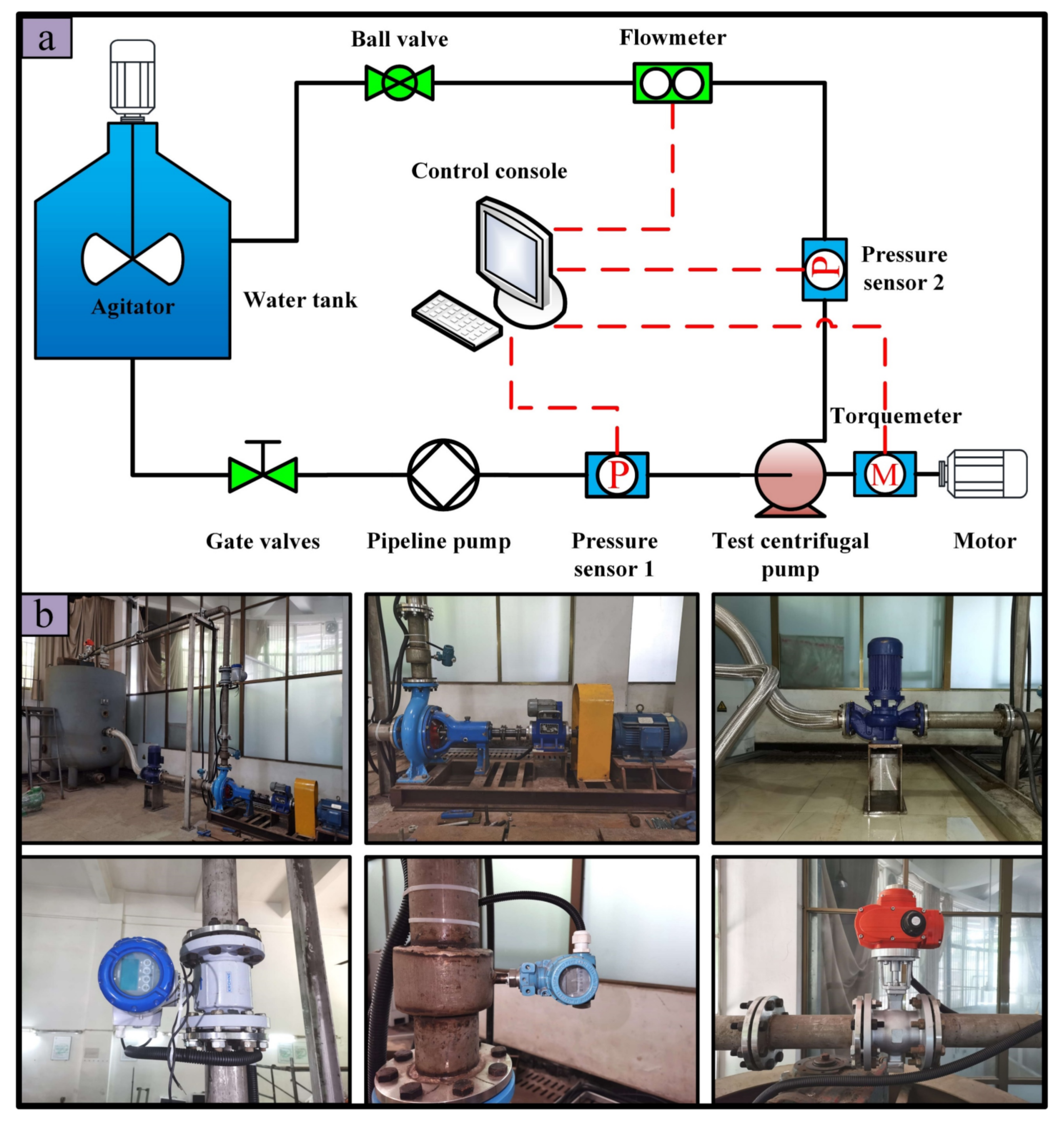

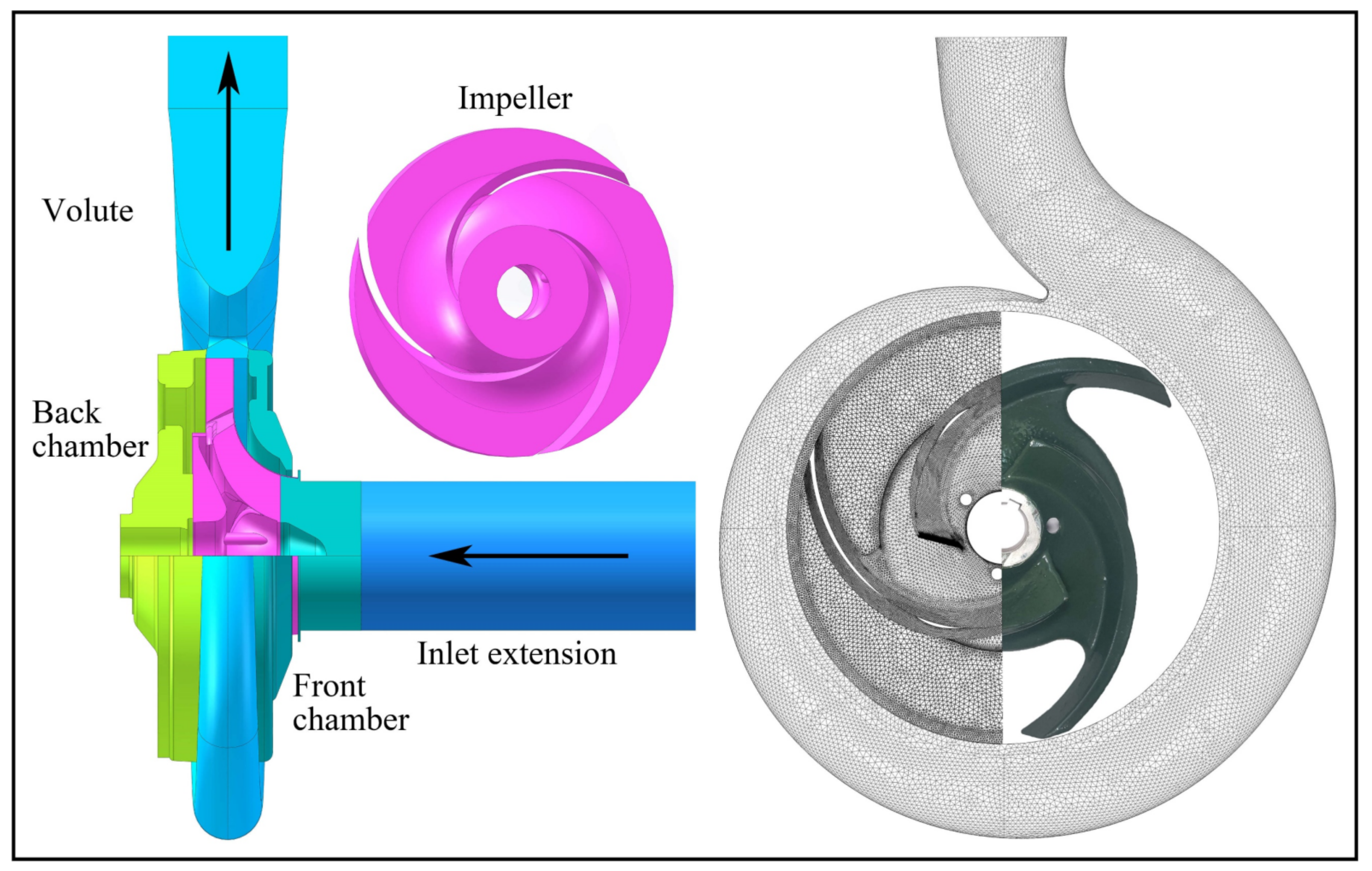
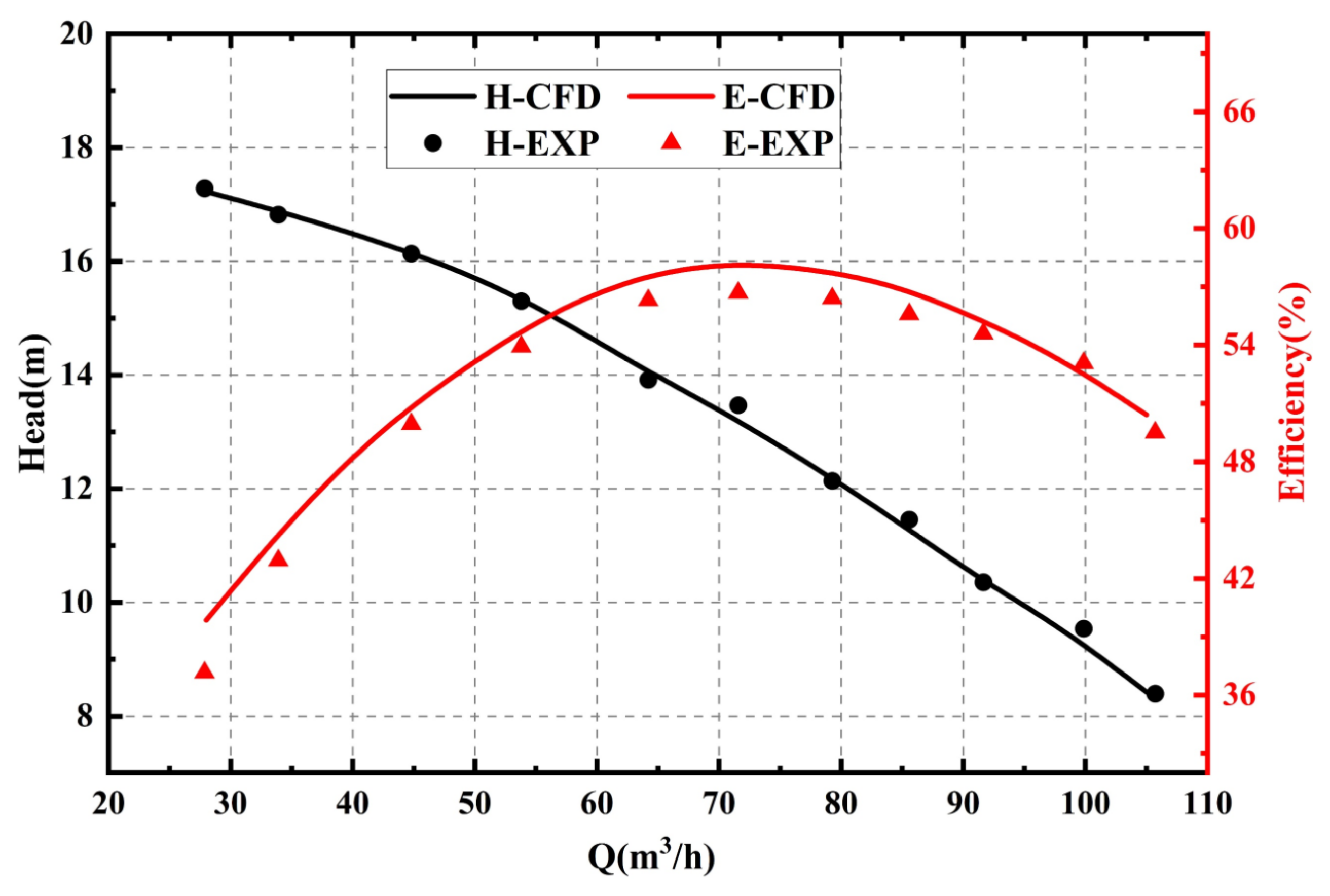

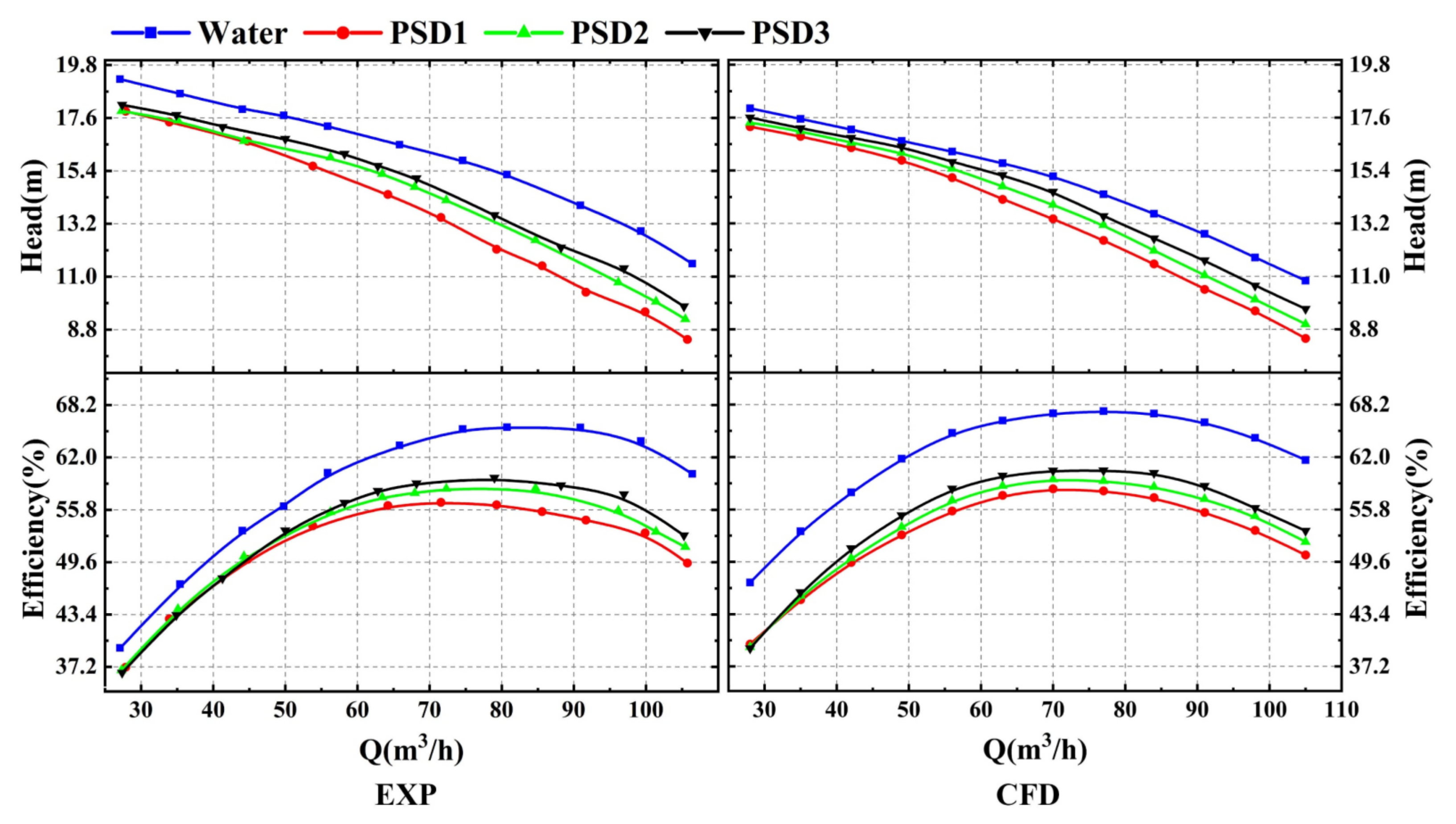
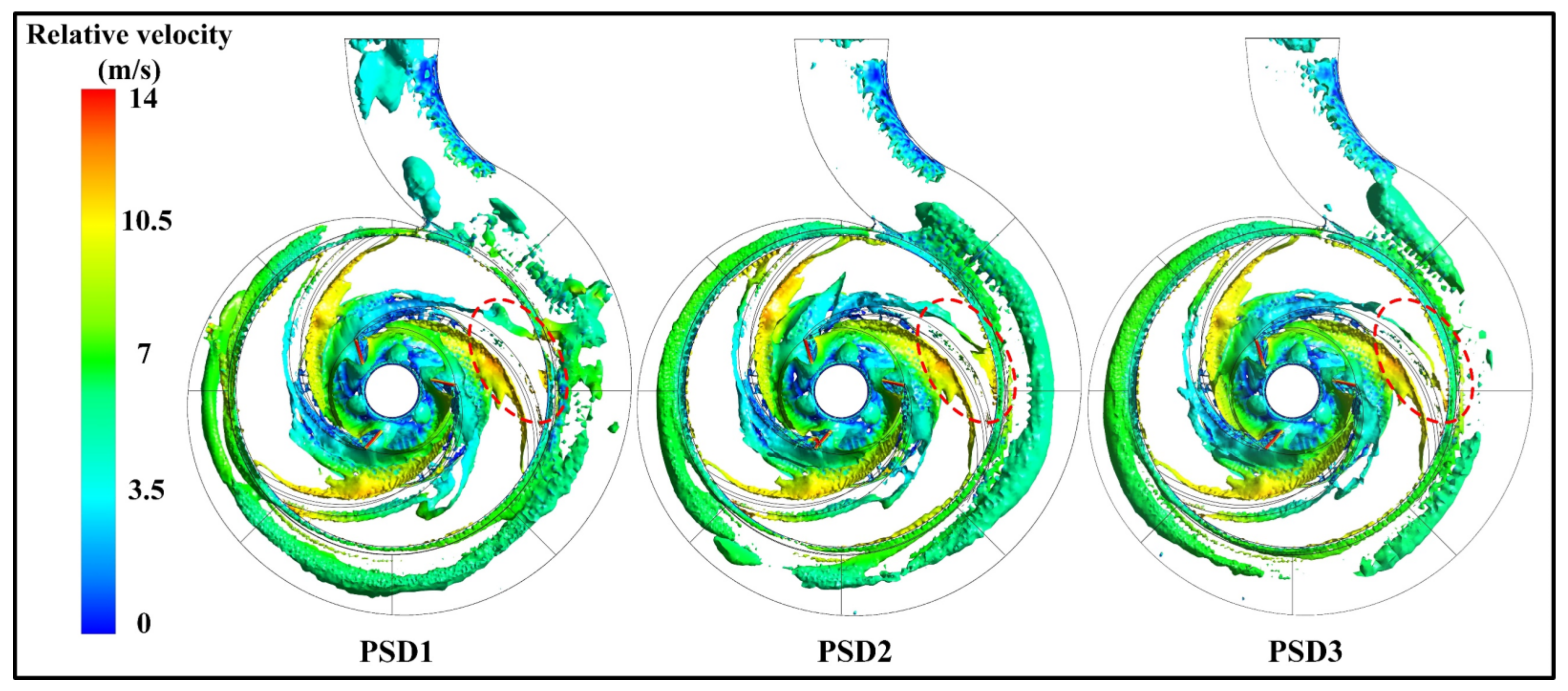

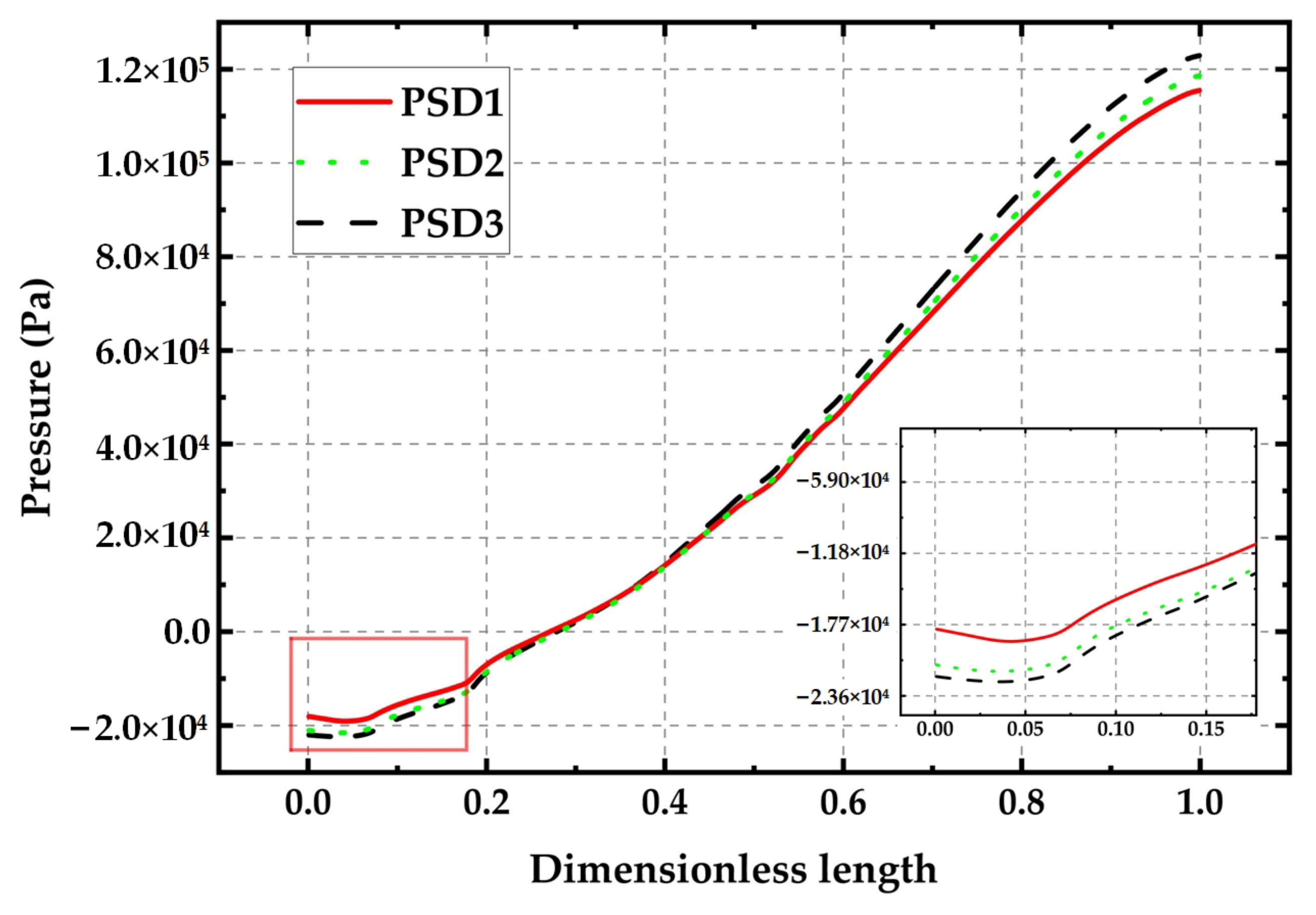

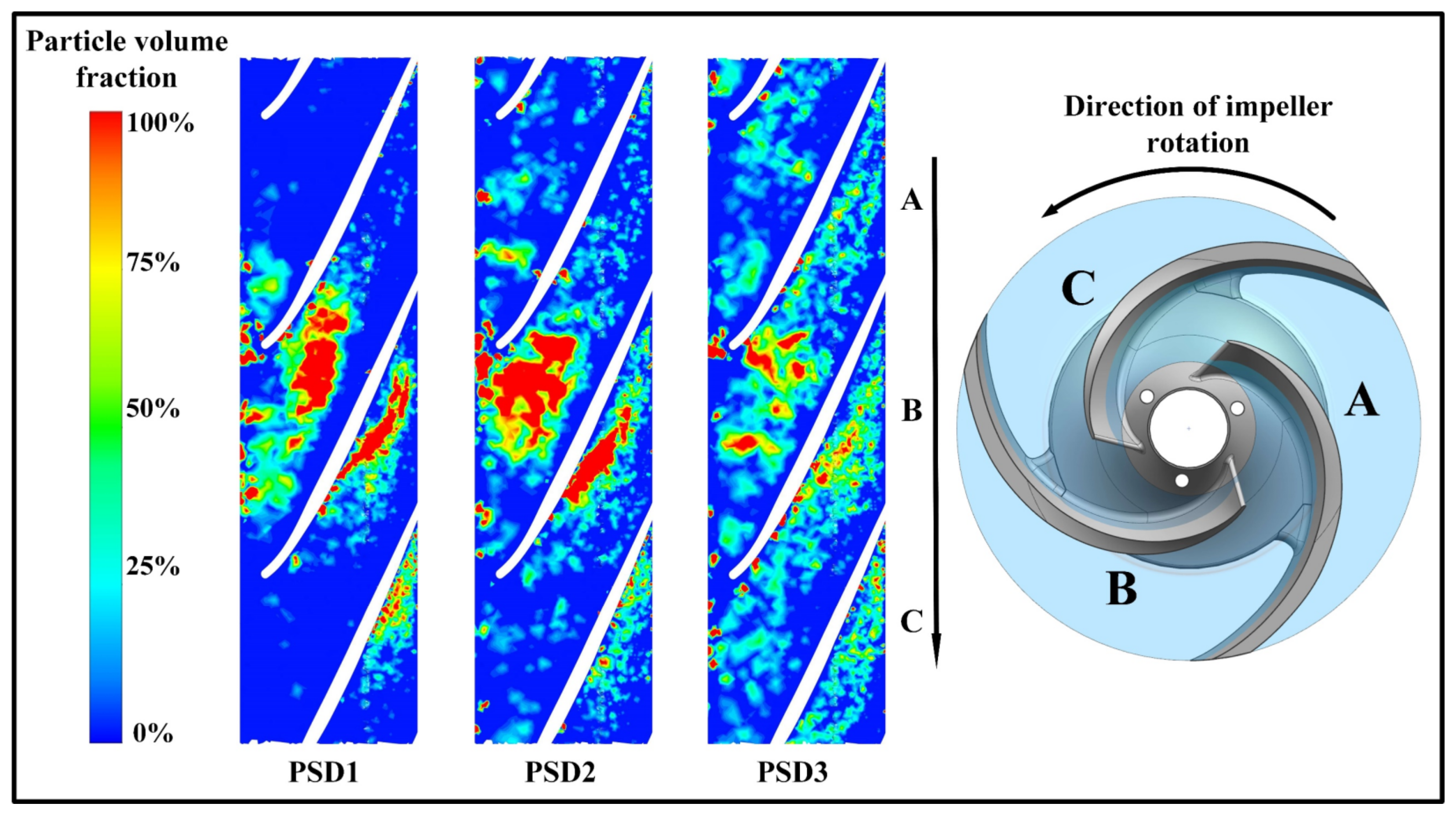
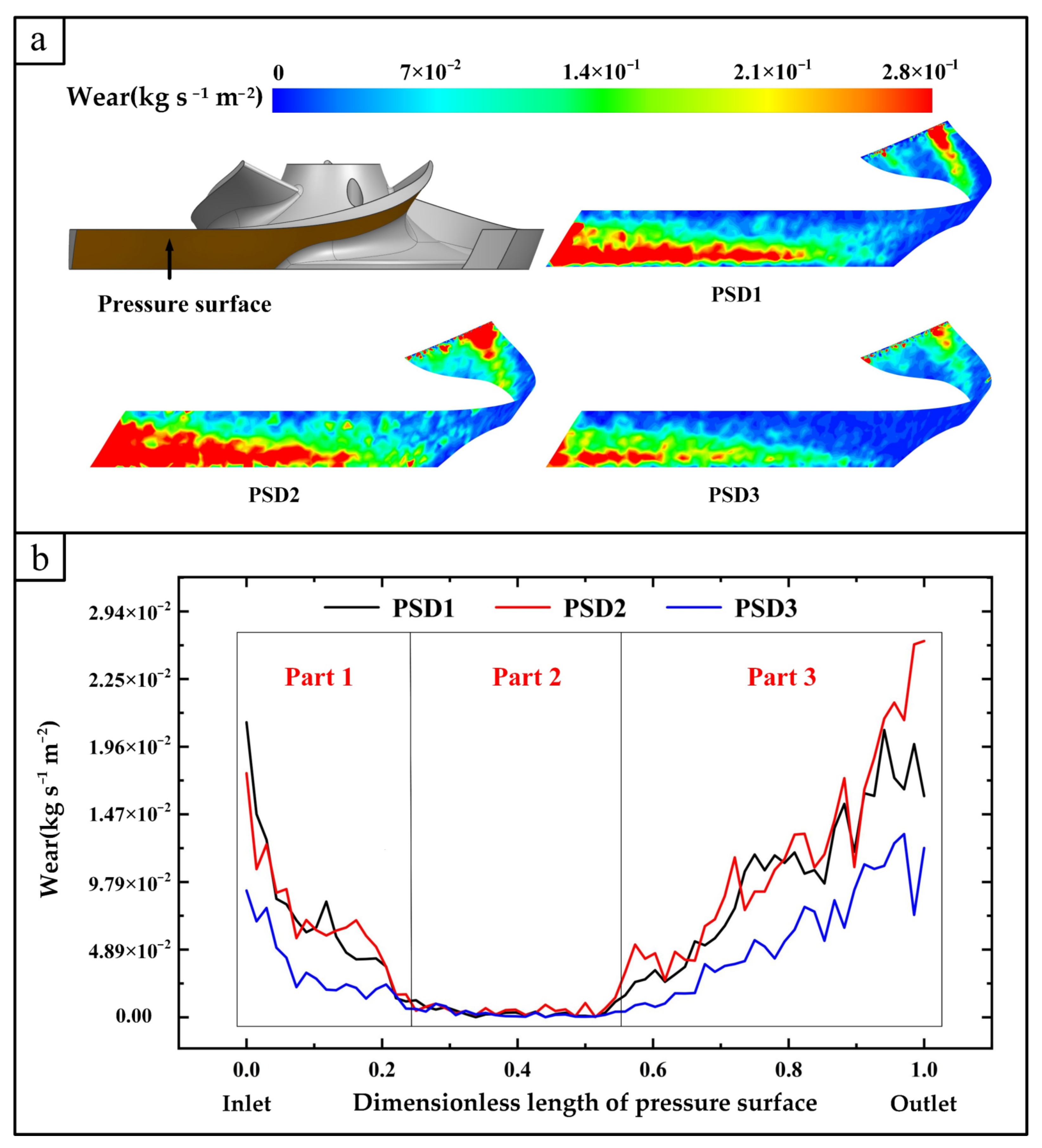

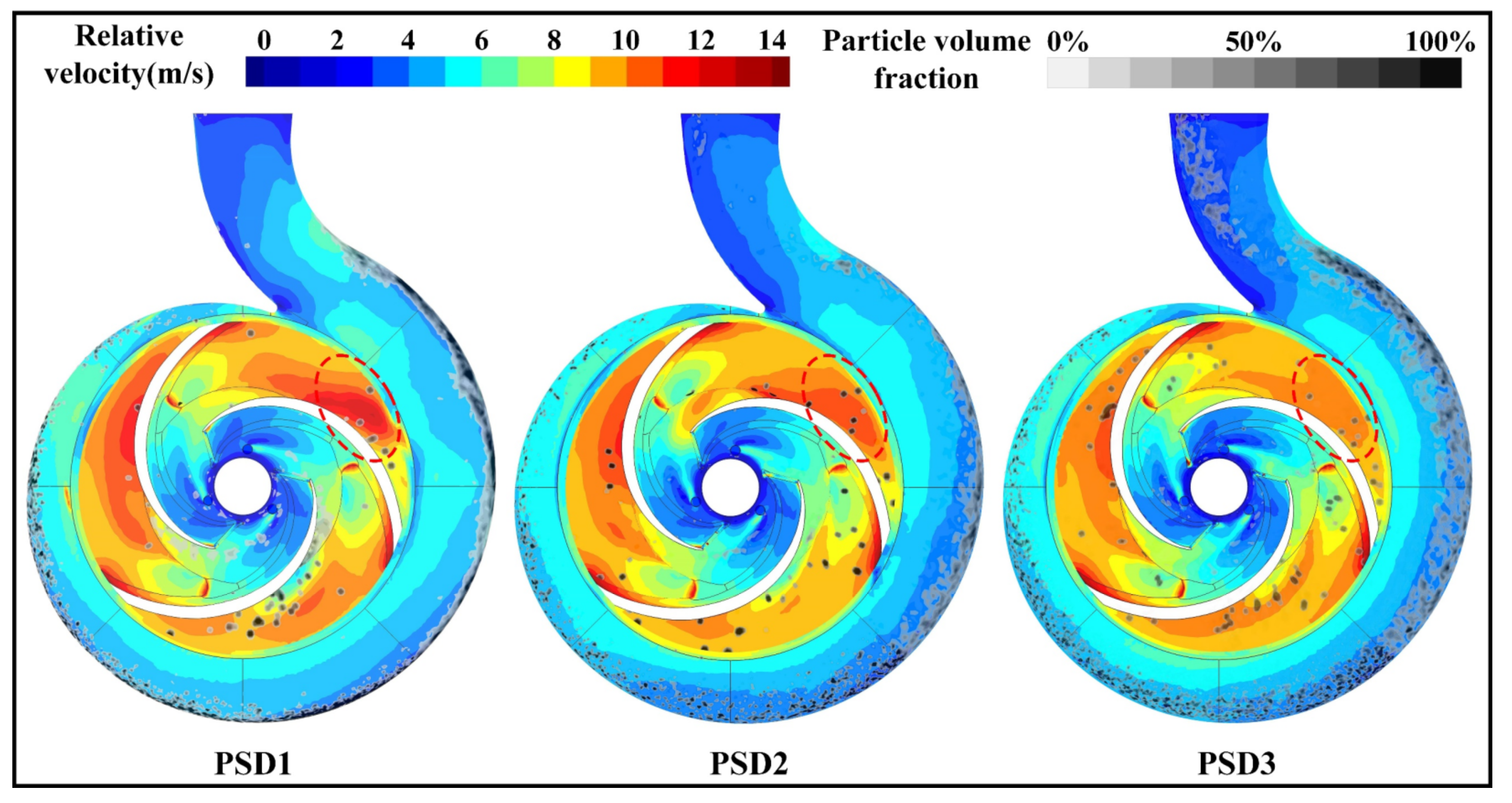
| Plan | d/mm | Ratio |
|---|---|---|
| PSD1 | 3 | 1 |
| 0.3 | 0 | |
| PSD2 | 3 | 0.7 |
| 0.3 | 0.3 | |
| PSD3 | 3 | 0.3 |
| 0.3 | 0.7 |
| A | nA | θ0 | a | b | x | y | x | w |
|---|---|---|---|---|---|---|---|---|
| 1.599 × 10−7 | 1.73 | Π/12 | −38.4 | 22.7 | 3.147 | 0.3609 | 2.532 | 1 |
| Serial Number of Grid | Number of Nodes | The Head of the Simulation (m) |
|---|---|---|
| 1 | 4.60426 × 105 | 15.28343 |
| 2 | 8.46013 × 105 | 15.32418 |
| 3 | 1.10640 × 106 | 15.28373 |
| 4 | 1.55974 × 106 | 15.24920 |
| 5 | 2.00676 × 106 | 15.19412 |
| 6 | 2.42731 × 106 | 15.19312 |
| 7 | 2.93915 × 106 | 15.18951 |
| 8 | 3.56107 × 106 | 15.18709 |
Publisher’s Note: MDPI stays neutral with regard to jurisdictional claims in published maps and institutional affiliations. |
© 2022 by the authors. Licensee MDPI, Basel, Switzerland. This article is an open access article distributed under the terms and conditions of the Creative Commons Attribution (CC BY) license (https://creativecommons.org/licenses/by/4.0/).
Share and Cite
Li, Y.; Zhuang, L.; Jiang, Z. Study of the Two-Phase Flow and Wear of a Pump with Mixed-Size Particles. Processes 2022, 10, 565. https://doi.org/10.3390/pr10030565
Li Y, Zhuang L, Jiang Z. Study of the Two-Phase Flow and Wear of a Pump with Mixed-Size Particles. Processes. 2022; 10(3):565. https://doi.org/10.3390/pr10030565
Chicago/Turabian StyleLi, Yi, Long Zhuang, and Zhongqian Jiang. 2022. "Study of the Two-Phase Flow and Wear of a Pump with Mixed-Size Particles" Processes 10, no. 3: 565. https://doi.org/10.3390/pr10030565
APA StyleLi, Y., Zhuang, L., & Jiang, Z. (2022). Study of the Two-Phase Flow and Wear of a Pump with Mixed-Size Particles. Processes, 10(3), 565. https://doi.org/10.3390/pr10030565






